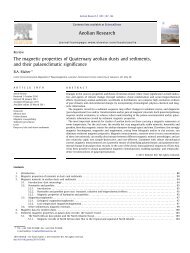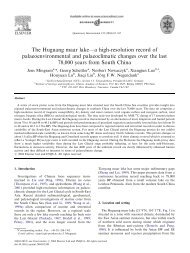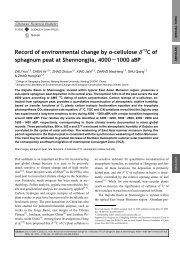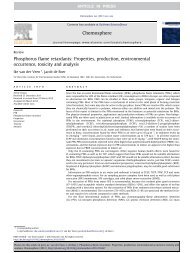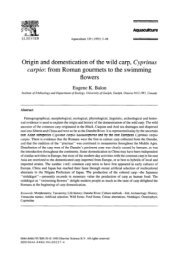Mono- and dicyclic unsaturated triterpenoid hydrocarbons in ...
Mono- and dicyclic unsaturated triterpenoid hydrocarbons in ...
Mono- and dicyclic unsaturated triterpenoid hydrocarbons in ...
You also want an ePaper? Increase the reach of your titles
YUMPU automatically turns print PDFs into web optimized ePapers that Google loves.
882 R. de Mesmay et al. / Organic Geochemistry 39 (2008) 879–893<br />
Chemical shifts were referenced relative to the residual<br />
proton signal (7.24 ppm) or the central l<strong>in</strong>e of the 13 C multiplet<br />
(77.0 ppm) of CDCl 3. Assignment of <strong>in</strong>dividual resonances<br />
was achieved us<strong>in</strong>g a comb<strong>in</strong>ation of 1D <strong>and</strong> 2D<br />
( 1 H- 1 H <strong>and</strong> 1 H- 13 C) experiments. Multiplicity of each 13 C<br />
nucleus was determ<strong>in</strong>ed us<strong>in</strong>g DEPT (enhanced polarisation<br />
transfer) spectra.<br />
3. Results <strong>and</strong> discussion<br />
3.1. Characterization of botryococcenes <strong>and</strong> reduced<br />
analogues<br />
3.1.1. Composition of hydrocarbon fraction<br />
Exam<strong>in</strong>ation of the hydrocarbon fraction isolated from<br />
the 1856–1871 cm depth sediment sample us<strong>in</strong>g GC-MS<br />
revealed a dom<strong>in</strong>ance (93% of total <strong>hydrocarbons</strong>; Table<br />
1; Fig. 2A) of botryococcenes (CnH2n-10) rang<strong>in</strong>g from C33<br />
to C37 <strong>and</strong> of partially reduced counterparts (CnH2n-8, CnH2n-6 <strong>and</strong> CnH2n-2), together with a m<strong>in</strong>or series of C17–C35<br />
n-alkanes. The botryococcenes <strong>and</strong> related compounds<br />
accounted for more than 246 lg/g dry sediment <strong>and</strong><br />
4 mg/g TOC (total organic carbon). The major compound<br />
was an unknown C34 component (c) account<strong>in</strong>g for ca.<br />
43% of the total <strong>hydrocarbons</strong>, each of the other components<br />
account<strong>in</strong>g for 87%).<br />
3.1.2. Characterization of C34 masokocene c<br />
The high resolution EI spectrum of the dom<strong>in</strong>ant botryococcene<br />
c displays M +. at m/z 466.4530, consistent with<br />
aC34H58 compound (calcd. 466.4522, D +0.8 mmu). The<br />
Table 1<br />
Composition, quantification <strong>and</strong> ozonolysis products of <strong>hydrocarbons</strong> from Lake Masoko sediment<br />
Hydrocarbon lg/g d.s. a<br />
Formula e<br />
MW Structure<br />
low resolution EI mass spectrum is characterised by a major<br />
ion at m/z 177, likely correspond<strong>in</strong>g to a fragmentation<br />
at the central quaternary carbon (Fig. 2B). Catalytic hydrogenation<br />
led to the formation of four botryococcanes<br />
C 34H 66 (H3, Fig. 3A) occurr<strong>in</strong>g <strong>in</strong> a 3/23/28/4 ratio, <strong>and</strong><br />
which exhibited identical mass <strong>and</strong> fragment ions<br />
(Fig. 3C). This <strong>in</strong>dicated the presence of two r<strong>in</strong>gs <strong>in</strong> c<br />
<strong>and</strong> suggested that stereochemical isomerisation occurred<br />
dur<strong>in</strong>g hydrogenation. The mass spectrum of H3 shows<br />
fragments at m/z 444/445 correspond<strong>in</strong>g to the loss of<br />
the C-10 ethyl, at m/z 236/237 correspond<strong>in</strong>g to loss of<br />
the long alkyl cha<strong>in</strong> at C-10 <strong>and</strong> at m/z 292/293 correspond<strong>in</strong>g<br />
to loss of the short alkyl cha<strong>in</strong> at C-10.<br />
Detailed <strong>in</strong>spection of the 1 H, 13 C, DEPT, COSY (correlation<br />
spectroscopy), HMQC (heteronuclear multiple quantum<br />
correlation) <strong>and</strong> HMBC (heteronuclear multiple bond<br />
correlation) NMR spectra of c (Table 2) <strong>and</strong> comparison<br />
with NMR data from other botryococcenes <strong>in</strong>dicated the<br />
presence of a term<strong>in</strong>al v<strong>in</strong>yl [dH 5.75 (H-26), 4.92 (H-<br />
27b), 4.90 (H-27a); d C 147.3 (C-26), 110.9 (C-27)] bound<br />
to the quaternary carbon C-10 (dC 41.8). The HMBC experiment<br />
further established that the latter quaternary carbon<br />
is correlated with an olef<strong>in</strong>ic proton (H-11, dH 5.26) of trans<br />
disubstituted unsaturation [J 11,12 = 16.0 Hz; H-12: d H 5.12].<br />
Moreover, long range correlations showed that a meth<strong>in</strong>e<br />
carbon (CH-13, d H 2.03, d C 37.1) bear<strong>in</strong>g a methyl (Me-<br />
28, dH 0.94, dC 21.2) is connected to this olef<strong>in</strong>. This C-10<br />
to C-13 substructure I (with methyls at C-10 <strong>and</strong> C-13<br />
<strong>and</strong> a v<strong>in</strong>yl at C-10, Fig. 4), is characteristic for all botryococcene<br />
structures (Metzger et al., 1985b); it arises from<br />
the 1’-3 condensation of two farnesyl units (Huang <strong>and</strong><br />
Poulter, 1989). The downfield region of the 1 H NMR spec-<br />
lg/g TOC b<br />
Relative% c<br />
Ozonolysis d<br />
C33H56 452 0.5 8.7 0.2<br />
C34H58 466 0.3 4.4 0.1<br />
C34H58 466 trace<br />
C34H66 474 a 0.8 13 0.3 O3 + O1<br />
C34H62 470 b 1.1 17 0.4 O11 + O1<br />
C34H58 466 c 114 1878 43.2 O11 + O9<br />
C34H58 466 d 12 191 4.4 O11 + O9<br />
C34H58 466 0.8 13 0.3<br />
C34H58 466 0.5 8.7 0.2<br />
C35H60 480 e 26 422 9.7 O11 + O10<br />
C36H62 494 f1, f2 5.8 96 2.2 O11 + O6<br />
C36H64 496 g1, g2 36 569 13.5 O11 + O4<br />
C36H62 494 0.5 8.7 0.2<br />
C37H64 508 h 10.6 174 4.0 O11 + O7<br />
C37H64 508 7.9 130 3.0 O11 + O7<br />
C37H66 510 i 18 291 6.7 O11 + O5<br />
C37H64 +C37H66 508/510 3.2 52 1.2<br />
C37H64 508 1.1 17 0.4<br />
C36H62 494 j 6.6 109 2.5 O11 + ?<br />
C37H66 510 0.3 4.4 0.1<br />
Other botryococcenes <strong>and</strong> n-alkanes 20 339 7.4<br />
R <strong>hydrocarbons</strong> 266 4346 100.0<br />
a Dry sediment.<br />
b Total organic carbon.<br />
c Composition determ<strong>in</strong>ed us<strong>in</strong>g GC.<br />
d Compounds from ozonolysis.<br />
e Compounds listed <strong>in</strong> elution order.



